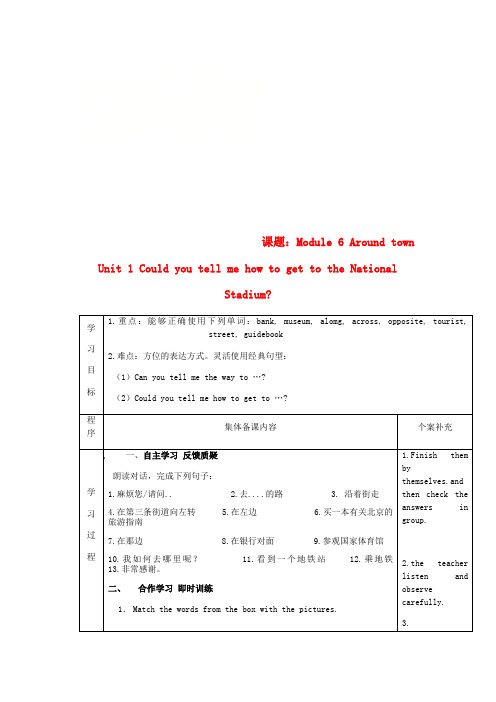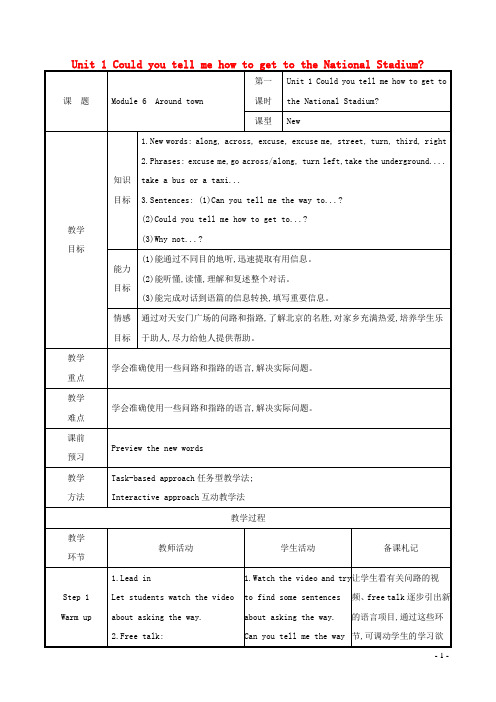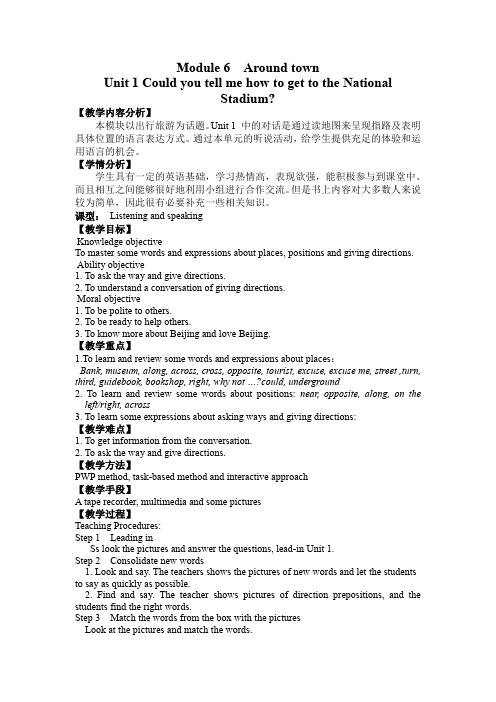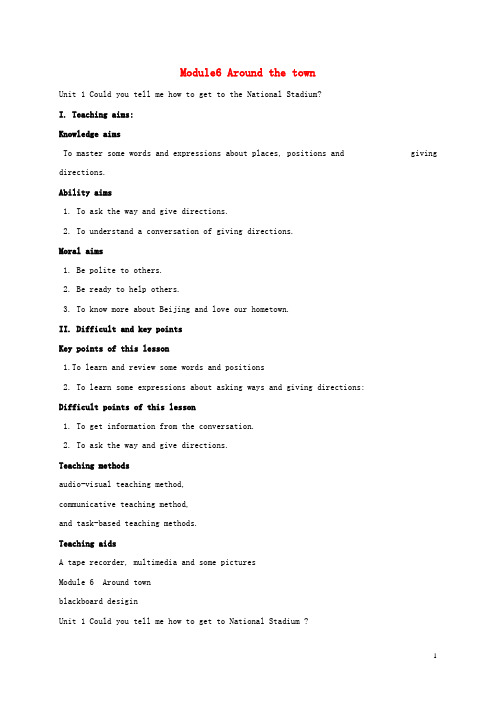2018版七年级英语下册Module6AroundtownUnit1CouldyoutellmehowtogettotheNationalStadium课后练习外研版
- 格式:doc
- 大小:82.50 KB
- 文档页数:2


课题:Module 6 Around town
Unit 1 Could you tell me how to get to the National
Stadium?
学 习 目 标 1.重点:能够正确使用下列单词:bank, museum, alomg, across, opposite, tourist,
street, guidebook 2.难点:方位的表达方式。
灵活使用经典句型: (1)Can you tell me the way to …? (2)Could you tell me ho w to get to …?
程序 集体备课内容
个案补充 学 习 过
程
一、
一、自主学习 反馈质疑
朗读对话,完成下列句子:
1.麻烦您/请问..
2.去....的路
3. 沿着街走
4.在第三条街道向左转
5.在左边
6.买一本有关北京的
旅游指南 7.在那边 8.在银行对面 9.参观国家体育馆
10.我如何去哪里呢? 11.看到一个地铁站 12.乘地铁
13.非常感谢。
二、 合作学习 即时训练 1. Match the words from the box with the pictures.
1.Finish them by
themselves.and then check the answers in group.
2.the teacher
listen and observe
carefully.
3.。

续表续表Post-listening (1)Show the map and ask thestudents to talk about it likethis:(地图附下表)Can you tell me the way to...?Go along the street, turnleft/right, opposite/near/between...and...(2)Have the students act outtheir new dialogues.Ask students to do someexercises and then check.groups with theteacher’s help. (地图附下表)(2)Act out the newdialogues.(3)Do the exercises, thencheck.巩固本课的语言重点。
同时锻炼学生的表达能力。
通过笔头练习,进一步巩固所学。
Step 5 Speaking 每小组选择不同的场景和任务,进行问路对话。
引进竞争机制,学生可以以组为单位进行展示。
语言输出环节,让学生把所学知识运用到各种具体情境中。
Step 6 Summarize Get students to sum up thelanguage points.T:What have we learned today?Ss:...Sum up the languagepoints.Asking the way:(1)Can you tell me the wayto...?(2)Could you tell me howto get to...?(3)Why not...?Leading the way:Go along/across..., turnleft...引导学生归纳总结培养学生自主学习的良好学习习惯。
Step 7 Consolidation 教师设置巩固检测练习。


Module 6 Around townUnit 1 Could you tell me how to get to the NationalStadium?【教学内容分析】本模块以出行旅游为话题。
Unit 1 中的对话是通过读地图来呈现指路及表明具体位置的语言表达方式。
通过本单元的听说活动,给学生提供充足的体验和运用语言的机会。
【学情分析】学生具有一定的英语基础,学习热情高,表现欲强,能积极参与到课堂中。
而且相互之间能够很好地利用小组进行合作交流。
但是书上内容对大多数人来说较为简单,因此很有必要补充一些相关知识。
课型:Listening and speaking【教学目标】Knowledge objectiveTo master some words and expressions about places, positions and giving directions. Ability objective1. To ask the way and give directions.2. To understand a conversation of giving directions.Moral objective1. To be polite to others.2. To be ready to help others.3. To know more about Beijing and love Beijing.【教学重点】1.To learn and review some words and expressions about places:Bank, museum, along, across, cross, opposite, tourist, excuse, excuse me, street ,turn, third, guidebook, bookshop, right, why not …?could, underground2. To learn and review some words about positions: near, opposite, along, on the left/right, across3. To learn some expressions about asking ways and giving directions:【教学难点】1. To get information from the conversation.2. To ask the way and give directions.【教学方法】PWP method, task-based method and interactive approach【教学手段】A tape recorder, multimedia and some pictures【教学过程】Teaching Procedures:Step 1 Leading inSs look the pictures and answer the questions, lead-in Unit 1.Step 2 Consolidate new words1. Look and say. The teachers shows the pictures of new words and let the students to say as quickly as possible.2. Find and say. The teacher shows pictures of direction prepositions, and the students find the right words.Step 3 Match the words from the box with the picturesLook at the pictures and match the words.Step 4 Work in pairs. Say which places in Activity 1 you can find in your hometown and where they are.Along across cross oppositeStep 5 Listen and read1. Listen and answer the question.Can the tourist go to the Wangfujing Dajie?2. Read the dialogue and answer the questions.(1) How will the tourist get to Wangfujing Dajie from Tian’anmen Square?(2) Where is the bookshop?(3) Who does the tourist ask for the way to the National Stadium?3. Point out the main points in the dialogue.Step 6 Complete the questions with the correct form of the words from the box.Then ask and answer the questions in pairs.1. ___________ me, is Wangfujing Dajie from Tian’anmen Square?2. There’re a bookshop near here. What’s the name of the ___________?3. Can a _________ ask a _________ the way to get to places in Beijing?4.____________ you tell me how to get to the National Stadium?5. Where’s the ___________ station?Step 7 Listen and repeat1. Can you tell me the way to Wangfujing Dajie?2. Go across Dong Chang’an Jie, go along the street and turn left.3. Is there a bookshop near here?4. Could you tell me how to get to the National Museum?5. Go along the street and you’ll see an underground station.Step 9 Work in pairs. Draw a map of where you live. Show places.Now ask for and give directions to places on map.-Where’s the market?-It’s on …-How do I get there?-Go along …Step 10 Grammar 问路的句型和指路的句型Step 11 Summary 1.方位介词的用法。

Module6 Around the townUnit 1 Could you tell me how to get to the National Stadium?I. Teaching aims:Knowledge aimsTo master some words and expressions about places, positions and giving directions.Ability aims1. To ask the way and give directions.2. To understand a conversation of giving directions.Moral aims1. Be polite to others.2. Be ready to help others.3. To know more about Beijing and love our hometown.II.Difficult and key pointsKey points of this lesson1.To learn and review some words and positions2. To learn some expressions about asking ways and giving directions:Difficult points of this lesson1. To get information from the conversation.2. To ask the way and give directions.Teaching methodsaudio-visual teaching method,communicative teaching method,and task-based teaching methods.Teaching aidsA tape recorder, multimedia and some picturesModule 6 Around townblackboard desiginUnit 1 Could you tell me how to get to National Stadium ?1. Where is …?Can you tell me the way to …?How can I get to …?2. Go along the street and you’ll see …Turn right / left .Take a bus / taxi .bankmuseumtouriststreetalongacrossOppositeTeaching-producesStep1: lead-in1.Show the ss some pictures about asking the way and ask some questions about it.let thestudents discuss the pictures.2.ask and answer in pairStep2: presentationSs learn the new words and look at the picture and match the words with the picture Step3: Listen and read1.ss listen to the dialogue and answer the questionCan the tourist go to the Wangfujing Dajie?2.read the dialogue and answer the questions.1. How will the tourist get to Wangfujing Dajie from Tian’anmen Square?2. Where is the bookshop?3. Who does the tourist ask for the way to the National Stadium?Step4:practiceplete the question with the correct form of the words in the box2.Read the conversation and complete the tableStep5 listen and read then Make notesSs listen and read the sentence1. Can you tell me the way to Wangfujing Dajie?2. Go across Dong Chang’an Jie,go along thestreet and turn left.3. Is there a bookshop near here?4. Could you tell me how to get to the NationalMuseum?5. Go along the street and you’ll see anunderground station.Step 6. Summary1.问路的句型:Excuse me. Where is …?How can I go / get to …?Can you tell me the way to …?Could you show me the way to …?2.指路的句型:Go along the street and you’ll see …Turn left/Turn right.Turn left into …Take the underground/Take a bus/taxi.。
Module6 Around the townUnit 1 Could you tell me how to get to the National Stadium?I. Teaching aims:Knowledge aimsTo master some words and expressions about places, positions and giving directions.Ability aims1. To ask the way and give directions.2. To understand a conversation of giving directions.Moral aims1. Be polite to others.2. Be ready to help others.3. To know more about Beijing and love our hometown.II.Difficult and key pointsKey points of this lesson1.To learn and review some words and positions2. To learn some expressions about asking ways and giving directions:Difficult points of this lesson1. To get information from the conversation.2. To ask the way and give directions.Teaching methodsaudio-visual teaching method,communicative teaching method,and task-based teaching methods.Teaching aidsA tape recorder, multimedia and some picturesModule 6 Around townblackboard desiginUnit 1 Could you tell me how to get to National Stadium ?1. Where is …?Can you tell me the way to …?How can I get to …?2. Go along the street and you’ll see …Turn right / left .Take a bus / taxi .bankmuseumtouriststreetalongacrossOppositeTeaching-producesStep1: lead-in1.Show the ss some pictures about asking the way and ask some questions about it.let thestudents discuss the pictures.2.ask and answer in pairStep2: presentationSs learn the new words and look at the picture and match the words with the picture Step3: Listen and read1.ss listen to the dialogue and answer the questionCan the tourist go to the Wangfujing Dajie?2.read the dialogue and answer the questions.1. How will the tourist get to Wangfujing Dajie from Tian’anmen Square?2. Where is the bookshop?3. Who does the tourist ask for the way to the National Stadium?Step4:practiceplete the question with the correct form of the words in the box2.Read the conversation and complete the table Step5 listen and read then Make notesSs listen and read the sentence1. Can you tell me the way to Wangfujing Dajie?2. Go across Dong Chang’an Jie,go along thestreet and turn left.3. Is there a bookshop near here?4. Could you tell me how to get to the National Museum?5. Go along the street and you’ll see anunderground station.Step 6. Summary1.问路的句型:Excuse me. Where is …?How can I go / get to …?Can you tell me the way to …?Could you show me the way to …?2.指路的句型:Go along the street and you’ll see …Turn left/Turn right.Turn left into …Take the underground/Take a bus/taxi.。
Unit 1 Could you tell me how to get to the National Stadium?
Ⅰ.用方框中的介词填空。
1.The policeman can tell you the way to Wangfujing Dajie.
2.You can see the post office on your left.
3.Walk across the street and the museum is opposite our building.
4.Go along the street and you’ll find the Science Museum.
5.It’s not far.There’s a book shop near here.
6.This is a guidebook about Shanghai.
7.At the third street you can turn left.
8.They want to know how to go across the river.
Ⅱ.根据首字母或汉语提示完成句中单词。
1.T urn left and you’ll see the post office.
2.People often keep their money in a b ank.
3.Make sure which bus you’ll take(乘坐)to the concert.
4.Don’t take photos at the museum(博物馆).It’s a rule.
5.Right(好了)!Let’s stop to talk about our plan for vacation.
Ⅲ.用括号内所给单词的适当形式填空。
1.When you walk across(cross) the road,you’d better look around.
2.导学号62434053I don’t know how to work(work) out this maths problem.
3.I’m very tired and I’d like to have(have) a rest.
4.Go along this street and you will find(find) the factory on your right.
5.Why not go(go) swimming with us,Lingling?
Ⅰ.从方框中选词或短语完成对话。
(A tourist would like t o go to the station.But he doesn’t know the way.)
Tourist:1.Excuse me,can you tell me the way to the station?
Policeman:Sure.Go 2.along the street,and 3.turn left at the third
crossing.You’ll see a square 4.on the right.Then you need to 5.cross the square.The station is 6.opposite the square.
Tourist:7.Right,OK.Is it far from here?
Policeman:Yes.You 8.could go there by bus or 9.why not take a taxi?It can 10. take you there.
Tourist:I will.Thank you very much.
Policeman:You’re welcome.Have a nice day!
Ⅱ.根据短文内容,用所给单词的适当形式填空,每词只能使用一次。
Jamie was going to a birthday party.The party was at a friend’s house.Jamie’s friend carefully wrote the directions(路线)to the party.Jamie didn’t k now the 1. town where his friend lived,so he left his house 2.early.For 20 minutes he followed the directions 3.carefully and got off at Exit 14.Then he began to have 4.problems.He couldn’t find the street.He drove around and around,and soon he was 5.lost.He stopped and asked people for directions,6.but no one knew that street.Jamie didn’t have his mobile phone with him.He left 7.it at home on the kitchen table.Suddenly he saw a 8.policeman.He stopped and asked him for 9. help.He looked at the directions and 10.smiled.。